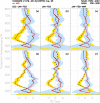The signs of Antarctic ozone hole recovery
- PMID: 28373709
- PMCID: PMC5429648
- DOI: 10.1038/s41598-017-00722-7
The signs of Antarctic ozone hole recovery
Abstract
Absorption of solar radiation by stratospheric ozone affects atmospheric dynamics and chemistry, and sustains life on Earth by preventing harmful radiation from reaching the surface. Significant ozone losses due to increases in the abundances of ozone depleting substances (ODSs) were first observed in Antarctica in the 1980s. Losses deepened in following years but became nearly flat by around 2000, reflecting changes in global ODS emissions. Here we show robust evidence that Antarctic ozone has started to recover in both spring and summer, with a recovery signal identified in springtime ozone profile and total column measurements at 99% confidence for the first time. Continuing recovery is expected to impact the future climate of that region. Our results demonstrate that the Montreal Protocol has indeed begun to save the Antarctic ozone layer.
Conflict of interest statement
The authors declare that they have no competing interests.
Figures



References
-
- World Meteorological Organization. Scientific Assessment of Ozone Depletion: 2011 (Report 53, Global Ozone Research and Monitoring Project, 2011).
-
- Farman JC, Gardiner BG, Shanklin JD. Large losses of total ozone in Antarctica reveal seasonal C1Ox/NOx interaction. Nature. 1985;315:207–210. doi: 10.1038/315207a0. - DOI
-
- Solomon S, Garcia RR, Rowland FS, Wuebbles DJ. On the depletion of Antarctic ozone. Nature. 1986;321:755–758. doi: 10.1038/321755a0. - DOI
-
- Hofmann DJ, Oltmans SJ, Harris JM, Solomon S, Deschler T, Johnson BJ. Observations and possible causes of new ozone depletion in Antarctica in 1991. Nature. 1992;359:283–287. doi: 10.1038/359283a0. - DOI
-
- Yang ES, et al. First stage of Antarctic ozone recovery. J. Geophys. Res. 2008;113:D20308. doi: 10.1029/2007JD009675. - DOI
LinkOut - more resources
Full Text Sources
Other Literature Sources

